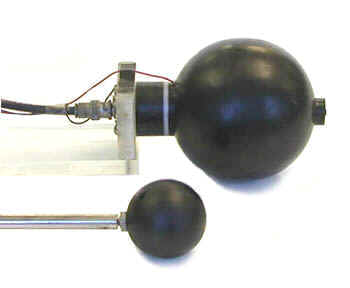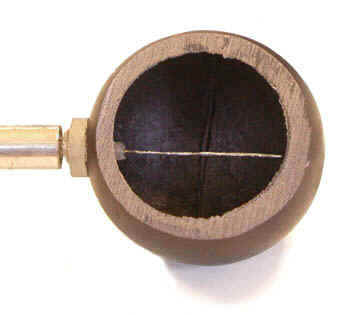Shonka Tissue Equivalent Ion Chambers (1960s)
In 1958 Francis Shonka developed what came to be known as A-150 tissue equivalent plastic. To a large extent, A-150 plastic has become the material of choice for constructing the ionization chambers and proportional counters used to measure the absorbed dose to tissue from neutrons and protons. These two ionization chambers were built by Shonka in the 1960s and used at the Medical Division of the Oak Ridge Institute of Nuclear Studies (ORINS) which is now known as Oak Ridge Associated Universities.


The larger of the two is 4" in diameter while the smaller chamber is 2" in diameter. The photograph above right shows the smaller of the two chambers with a portion of the wall removed. The anode is a rigid wire supported at one end.
The larger chamber was used in the ORINS Low Dose Rate Whole Body irradiation facility where patients were exposed to 1 R/hr gamma fields for many days at a time in enclosed self-sufficient living quarters. The smaller chamber was intended for use as a transfer standard.
The elemental composition of A-150 was based on the recommendations of the 1956 Report on the International Committee on Radiation Units and Measurements (NBS Handbook 62, p. 12). The problem Shonka was faced with was developing a plastic that was also strong, machinable, moldable, conductive, chemically stable and had a low gas permeability. The result of his research was a mixture of calcium fluoride, polyethylene, nylon and carbon.
A-150 Muscle Tissue
Hydrogen 10% 10%
Nitrogen 3.5% 3%
Carbon 76.1% 11%
Oxygen 5.2% 74%
A-150 plastic is a good but not perfect match for tissue. The hydrogen and nitrogen contents of A-150 and tissue are identical but their carbon and oxygen contents are almost reversed. Fortunately, the oxygen and carbon neutron kerma factors are very similar. And because the kerma factor for hydrogen is so much larger than that of carbon and oxygen, the neutron kerma factors for A-150 and muscle tissue are nearly identical. With regard to the chamber's response to gamma rays and X-rays, the effective atomic numbers of A-150 and tissue are reasonably close.
The typical wall thickness is 0.52 g/cm2—thick enough to achieve charged particle equilibrium for neutrons up to 20 MeV and transient charged particle equilibrium for Co-60 gamma rays.
Although I have no specific information concerning the gas used in these chambers, it was almost certainly a methane based tissue equivalent gas. When the gas and wall are both tissue equivalent, the Bragg-Gray equation simplifies because the ratio of the mass stopping powers (sm) for the gas and wall becomes one. Hence:
Dw = sm Dg = Dg
Where Dw is the absorbed dose to the wall of the detector and Dg is the absorbed dose to the gas of the chamber
In addition, the Bragg-Gray condition that the size of the detector cavity be kept small is relaxed.
References
- F. Shonka, J. E. Rose, and G. Failla, "Conducting plastic equivalent to tissue, air and polystyrene," in Second United Nations International Conference on Peaceful Uses of Atomic Energy. New York: United Nations, 1958, p. 160.
- Jack Beck. Personal communication.
